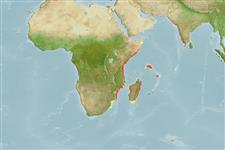Common names from other countries
>
Mulliformes (Goatfishes) >
Mullidae (Goatfishes)
Etymology: Parupeneus: Latin, parum, parvum = small + Peneus, the name of a river; minys: Name from the Greek word for small, referring to its very small adult size for this genus..
More on authors: Randall & Heemstra.
Environment: milieu / climate zone / depth range / distribution range
Ekologi
laut berasosiasi dengan karang; kisaran kedalaman 43 - 55 m (Ref. 82838). Tropical
Western Indian Ocean: Mozambique, Seychelles and India.
Size / Weight / umur
Maturity: Lm ? range ? - ? cm
Max length : 10.7 cm SL jantan/; (Ref. 82838); 8.4 cm SL (female)
deskripsi pendek
Kunci identifiaksi (pengenalan) | Morfologi | Morfometrik
Duri punggung (Keseluruhan (total)) : 8; duri punggung lunak (Keseluruhan (total)) : 9; Duri dubur: 0; Sirip dubur lunak: 7; vertebrata, bertulang belakang: 24. This species is distinguished by the following characters: pectoral-fin rays 15-16; gill rakers 6 + 21-22; elongated body, depth 3.95-4.3 in SL; head length 2.9-3.05 in SL; interorbital space flat medially; snout length 2.05-2.3 in HL; posterior edge of maxilla symmetrically convex with maximum depth of maxilla 5.45-5.8 in HL; barbel length 1.35-1.45 in HL; the longest dorsal spine 1.8-1.95 in HL; pectoral fins 1.3-1.4 in HL; pelvic fins 1.5-1.65 in HL; colour of alcohol preserved specimens uniform tan except those from the Seychelles with areas of white ventrally on head below eye and on lower two/fifths of body; dark markings absent; translucent fins pale yellowish. Colour when fresh, pink dorsally, pale pink to white ventrally, with an indistinct pale yellow stripe along lateral line; some lateral-line scales with a bluish white dash; a bluish white line encircling ventral part of eye and continuing obliquely to upper lip; 3 small bluish white blotches dorsally on head, one directly above eye; barbels white; median and pelvic fins translucent blotchy yellow with small pale blue to whitish spots along rays that outline faint transverse yellowish bands (Ref. 82838).
Life cycle and mating behavior
Maturities | Reproduksi, perkembang biakan | Spawnings | Egg(s) | Fecundities | Larva
Randall, J.E. and E. Heemstra, 2009. Three new goatfishes of the genus Parupeneus from the Western Indian Ocean, with resurrection of P. seychellensis. Smithiana Bulletin 10:37-50. (Ref. 82838)
Status IUCN Red List (Ref. 130435)
CITES (Ref. 128078)
Not Evaluated
ancaman kepada manusia
Harmless
penggunaan manusia
Alat, peralatan
laporan khas
muat turun XML
Sumber internet
Estimates based on models
Preferred temperature (Ref.
115969): 25.5 - 26.1, mean 26.1 (based on 3 cells).
Phylogenetic diversity index (Ref.
82804): PD
50 = 0.5000 [Uniqueness, from 0.5 = low to 2.0 = high].
Bayesian length-weight: a=0.01202 (0.00556 - 0.02601), b=3.10 (2.93 - 3.27), in cm Total Length, based on LWR estimates for this Genus-body shape (Ref.
93245).
Trophic level (Ref.
69278): 3.3 ±0.4 se; based on size and trophs of closest relatives
Daya lenting (Ref.
120179): Tinggi, Waktu penggandaan populasi minimum kurang dari 15 bulan (Preliminary K or Fecundity.).
Fishing Vulnerability (Ref.
59153): Low vulnerability (10 of 100).
